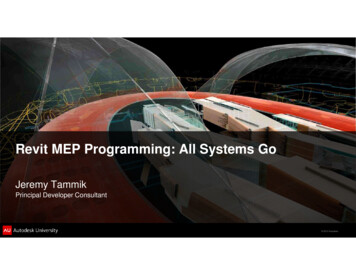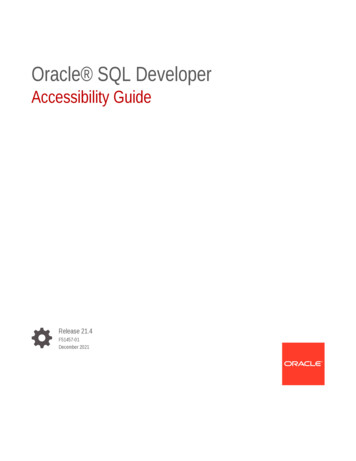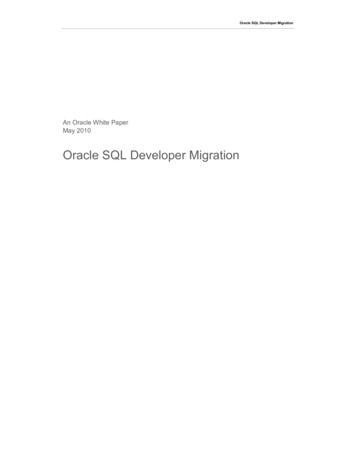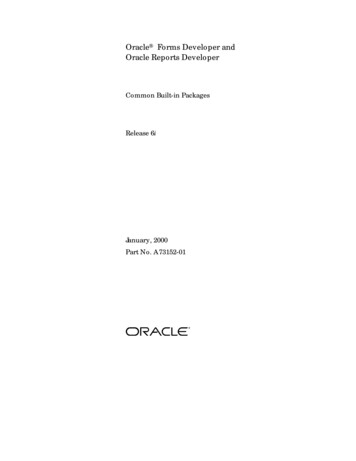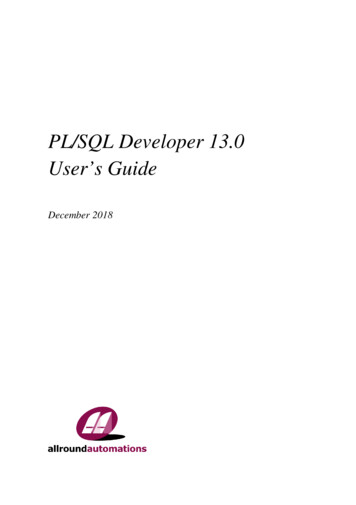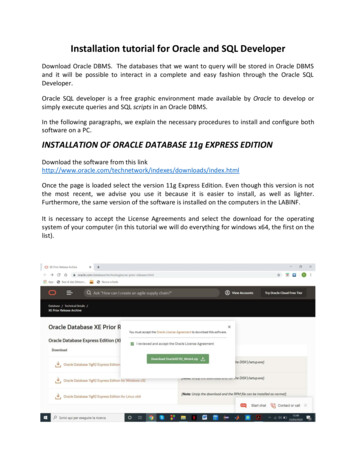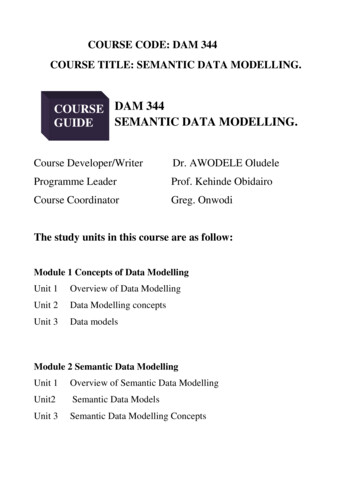
Transcription
COURSE CODE: DAM 344COURSE TITLE: SEMANTIC DATA MODELLING.COURSE DAM 344SEMANTIC DATA MODELLING.GUIDECourse Developer/WriterDr. AWODELE OludeleProgramme LeaderProf. Kehinde ObidairoCourse CoordinatorGreg. OnwodiThe study units in this course are as follow:Module 1 Concepts of Data ModellingUnit 1Overview of Data ModellingUnit 2Data Modelling conceptsUnit 3Data modelsModule 2 Semantic Data ModellingUnit 1Overview of Semantic Data ModellingUnit2Semantic Data ModelsUnit 3Semantic Data Modelling Concepts
Module 3Areas of Application of Semantic Data ModellingUnit 1Application in ComputerUnit 2Application in Business
Module 1 Concepts of Data ModellingUnit 1 Overview of Data Modelling1.0Introduction2.0Objectives3.0Definition of Data Modelling3.1Types of Data Modelling3.2Use of Data Modelling3.3Data Modelling Process3.4Modelling Methodologies3.5Benefits of Data Modelling3.6Properties of Data4.0Conclusion5.0Summary6.0Tutor Marked Assignment7.0Further Reading and Other Resources
1.0IntroductionData modelling is a critical skill for IT professionals including someonewho is familiar with relational databases but who has no experience in datamodelling, such people as database administrators (DBAs), data modellers,business analysts and software developers. It is an essential ingredient ofnearly all IT projects. Without a data model there is no blueprint for thedesign of the database.Then, there are two important things to keep in mind when learning aboutand doing data modelling:Data modelling is first and foremost a tool for communication. There isno single “right” model. Instead, a valuable model highlights tricky issues,allows users, designers, and implementers to discuss the issues using thesame vocabulary, and leads to better design decisions.The modelling process is inherently iterative: you create a model, checkits assumptions with users, make the necessary changes, and repeat thecycle until you are sure you understand the critical issues.2.0ObjectivesAt the end of this unit, you should be able to: Describe what data modelling is and why it is required Mention types and uses of data modelling Describe the process of data modelling, with the aid of diagram Describe the outstanding data modelling methodologies List and explain the properties of data
3.0Definition of Data ModellingData modelling is the process of creating and extending data models whichare visual representations of data and its organization. The ERD Diagram(Entity Relationship Diagram) is the most popular type of data model. Insoftware engineering, it is the process of creating a data model by applyingformal data model descriptions using data modelling techniques.It is a method used to define and analyze data requirements needed tosupport the business processes of an organization. Data modelling definesnot just data elements, but their structures and relationships between them.Data modelling is also a technique for detailing business requirements for adatabase, and it is sometimes called database modelling because, a datamodel is eventually implemented in a database.3.1Types of Data ModellingData modelling may be performed during various types of projects and inmultiple phases of projects. Data models are progressive; there is no suchthing as the final data model for a business or application. Instead a datamodel should be considered a living document that will change in responseto a changing business. The data models should ideally be stored inrepository so that they can be retrieved, expanded, and edited over time.Whitten (2004) determined two types of data modelling: Strategic data modelling: This is part of the creation of aninformation systems strategy, which defines an overall vision and
architecture for which, information systems is defined. Informationengineering is a methodology that embraces this approach. Data modelling during systems analysis: In systems analysis logicaldata models are created as part of the development of new databases.3.2 Use of Data ModellingData modelling techniques and methodologies are used to model data in astandard, consistent, predictable manner in order to manage it as a resource.The use of data modelling standards is strongly recommended for allprojects requiring a standard means of defining and analyzing data withinan organization, e.g., using data modelling: To manage data as a resource; For the integration of information systems; For designing databases/data warehouses (a.k.a data repositories)3.3 Data Modelling ProcessThe actual database design is the process of producing a detailed data modelof a database. This logical data model contains all the needed logical andphysical design choices and physical storage parameters needed to generatea design in a Data Definition Language, which can then be used to create adatabase. A fully attributed data model contains detailed attributes for eachentity. The term database design can be used to describe many differentparts of the design of an overall database system.
Principally, and most correctly, it can be thought of as the logical design ofthe base data structures used to store the data. In the relational model theseare the tables and views. In an Object database the entities and relationshipsmap directly to object classes and named relationships. However, the termdatabase design could also be used to apply to the overall process ofdesigning, not just the base data structures, but also the forms and queriesused as part of the overall database application within the DatabaseManagement System or DBMS.Figure 1.The data modelling processThe figure illustrates the way data models are developed and used today. A conceptualdata model is developed based on the data requirements for the application that isbeing developed, perhaps in the context of an activity model. The data model willnormally consist of entity types, attributes, relationships, integrity rules, and thedefinitions of those objects. This is then used as the start point for interface or databasedesign.
3.4 Modelling MethodologiesThough data models represent information areas of interest, and there aremany ways to create data models, according to Len Silverston (1997), onlytwo modelling methodologies stand out: Bottom-up models: These are often the result of a reengineeringeffort. They usually start with existing data structures forms, fields onapplication screens, or reports. These models are usually physical,application-specific, and incomplete from anenterprise perspective.They may not promote data sharing, especially if they are builtwithout reference to other parts of the organization. Top-down logical data models: These on the other hand, are createdin an abstract way by getting information from people who know thesubject area. A system may not implement all the entities in a logicalmodel, but the model serves as a reference point or template.Sometimes models are created in a mixture of the two methods; byconsidering the data needs and structure of an application and byconsistently referencing a subject-area model. Unfortunately, in manyenvironments the distinction between a logical data model and a physicaldata model is blurred. In addition, some CASE tools don‟t make adistinction between logical and physical data models.3.5Benefits of Data ModellingAbstraction: The act of abstraction expresses a concept in its minimum,most universal set of properties. A well abstracted data model will be
economical and flexible to maintain and enhance accuracy, since it willutilize few symbols to represent a large body of design. If we can make ageneral design statement which is true for a broad class of situations, thenwe do not need to recode that point for each instance. We save repetitivelabour; minimize multiple opportunities for human error; and enable broadscale, uniform change of behaviour by making central changes to theabstract definition.In data modelling, strong methodologies and tools provide several powerfultechniques which support abstraction. For example, a symbolic relationshipbetween entities need not specify details of foreign keys since they aremerely a function of their relationship. Entity sub-types enable the model toreflect real world hierarchies with minimum notation. Automatic resolutionof many-to-many relationships into the appropriate tables allows themodeller to focus on business meaning and solutions rather than technicalimplementation.Transparency: Transparency is the property of being intuitively clearand understandable from any point of view. A good data model enables itsdesigner to perceive truthfulness of design by presenting an understandablepicture of inherently complex ideas. The data model can reveal inaccurategrouping of information (normalization of data items), incorrectrelationships between objects (entities), and contrived attempts to force datainto preconceived processing arrangements.It is not sufficient for a data model to exist merely as a single globaldiagram with all content smashed into little boxes. To provide transparencya data model needs to enable examination in several dimensions and views:
diagrams by functional area and by related data structures; lists of data structures by type and groupings; context-bound explosions of details withinabstract symbols; data based queries into the data describing the model.Effectiveness: An effective data model does the right job - the one forwhich it was commissioned - and does the job right - accurately, reliably,and economically. It is tuned to enable acceptable performance at anaffordable operating cost.To generate an effective data model the tools and techniques must not onlycapture a sound conceptual design but also translate into a workablephysical database schema. At that level a number of implementation issues(e.g., reducing insert and update times; minimizing joins on retrievalwithout limiting access; simplifying access with views; enforcing referentialintegrity) which are implicit or ignored at the conceptual level must beaddressed.An effective data model is durable; that is it ensures that a system built onits foundation will meet unanticipated processing requirements for years tocome. A durable data model is sufficiently complete that the system doesnot need constant reconstruction to accommodate new businessrequirements and processes.3.6Properties of DataSome important properties of data for which requirements need to be metare:
definition-related propertieso relevance: the usefulness of the data in the context of yourbusiness.o clarity: the availability of a clear and shared definition for thedata.o consistency: the compatibility of the same type of data fromdifferent sources. content-related propertieso timeliness: the availability of data at the time required and howup to date that data is.o accuracy: how close to the truth the data is.properties related to both definition and contento completeness: how much of the required data is available.o accessibility: where, how, and to whom the data is available ornot available (e.g. security).o cost: the cost incurred in obtaining the data, and making itavailable for use. Figure 2.Some important properties of data
4.0ConclusionWith the overview of data modelling, individuals and organizations canuncover hidden processes, methodologies, as well as the benefits ofmodelling their data, which they can use to predict the behaviour ofcustomers, products and processes.5.0SummaryIn this unit we have learnt that: Data modelling is a critical skill for IT professionals, and that, it isfirst and foremost a tool for communication and inherently iterative. Data modelling is the process of creating and extending data modelswhich are visual representations of data and its organization. Some of the uses of data modelling include data management,integration of information systems, and designing of databases. Benefits of data modelling are abstraction, transparency andeffectiveness.6.01.Tutor Marked Assignment(a) What do you understand by the term data modelling?(b) Explain the modelling processes and mention its methodologies.2.(a) Simply explain the benefits of data modelling(c) Mention the various properties of data
7.0Further Reading and Other ResourcesE.F. Codd (1970). "A relational model of data for large shared data banks".In: Communications of the ACM archive. Vol 13. Issue 6(June .aspxData Integration Glossary, U.S. Department of Transportation, August 20Whitten, Jeffrey L.; Lonnie D. Bentley, Kevin C. Dittman. (2004). SystemsAnalysis and Design Methods. 6th edition. ISBN 025619906XAmerican National Standards Institute. 1975. ANSI/X3/SPARC Study Groupon Data Base Management Systems; Interim Report. FDT (Bulletin ofACM SIGMOD) 7:2.Semantic data modeling" In: Metaclasses and Their Application. BookSeries Lecture Notes in Computer Science. Publisher Springer Berlin /Heidelberg. Volume Volume 943/1995.FIPS Publication 184 released of IDEF1X by the Computer SystemsLaboratory of the National Institute of Standards and Technology (NIST).21 December 1993Len Silverston, W.H.Inmon, Kent Graziano (2007). The Data ModelResource Book. Wiley, 1997. ISBN 0-471-15364-8. Reviewed by Van Scotton tdan.com. Accessed 1 Nov 2008.Paul R. Smith & Richard Sarfaty (1993). Creating a strategic plan forconfiguration management using Computer Aided Software Engineering(CASE) tools. Paper For 1993 National DOE/Contractors and FacilitiesCAD/CAE User's Group.
Module 1 Concepts of Data ModellingUnit 2 Data Modelling Concepts1.0Introduction2.0Objective3.0Generic Data Modelling3.1Concept of Identifier, Modifier, and Descriptor3.2Relational Model and Concept of Relationships3.3Attributes Concept3.4Entity Concept3.5Entity Relationship Model3.6Common Data Modelling Notations4.0Conclusion5.0Summary6.0Tutor Marked Assignment7.0Further Reading and Other Resources
1.0IntroductionThe motive of data modelling concepts is that, all developers should haveskills that can be applied on project, with the philosophy that, every ITprofessional should have a basic understanding of data modelling. This is abrief introduction to these skills. So, it is critical for application developersto understand the concepts and appreciate the fundamentals of datamodelling2.0ObjectiveAt the end of this unit, you should be able to: Describe generic data model Differentiate between identifier, modifier and descriptor Explain different concepts of data modelling Explain with the aid of diagram, the syntax of common data modellingnotations3.0Generic Data ModellingGeneric data models are generalizations of conventional data models. Theydefine standardized general relation types, together with the kinds of thingsthat may be related by such a relation type. The definition of generic datamodel is similar to the definition of a natural language. For example, ageneric data model may define relation types such as a 'classificationrelation', being a binary relation between an individual thing and a kind ofthing (a class) and a 'part-whole relation', being a binary relation betweentwo things, one with the role of part, the other with the role of whole,
regardless the kind of things that are related.Given an extensible list of classes, this allows the classification of anyindividual thing and to specify part-whole relations for any individualobject. By standardization of an extensible list of relation types, a genericdata model enables the expression of an unlimited number of kinds of factsand will approach the capabilities of natural languages. Conventional datamodels, on the other hand, have a fixed and limited domain scope, becausethe instantiation (usage) of such a model only allows expressions of kindsof facts that are predefined in the model.Figure 3.Example of a Generic data model
3.1Concept of Identifier, Modifier, and DescriptorIdentifier (I):Identifiers serve as the primary identification terms, or keys, necessary touniquely identify things and events, or classes of them. They symbolicallyrepresent things and events (entities) and provide for the necessaryidentification of conceptual objects. Importantly, identifiers provide theskeletal structure upon which all other types of data depend. They alsoprovide a means for explicitly defining the relationships between things andevents (entities), which enables data sharing among users. Typicalidentifiers include: patient, account, part and purchase order numbers.Modifier (M):Modifiers serve as sub-entity identifiers and expand upon or refine primaryidentification (identifiers). As variant forms of identification, they cannotstand alone. Modifiers must be used in conjunction with identifiersto form fully qualified identification terms. They primarily are used toidentify such things as: time, occurrence, use, type, sequence, etc. Modifiershave a unique data element value for each variation of the identifieraddressed and can exist with one-to-one (1:1) or one-to-many (1:m)cardinality. Typical modifiers include: dates, type codes, serial numbers andrevisions.Descriptor (D):Descriptors are non-identification data elements used to characterize entitiesand relationships of them. There are no logical dependencies between
descriptors and they can only exist when associated with an identifier oridentifier-modifier combination. Descriptors comprise the majority of alldata elements and frequently are textual or codified data element values -data that must be further interpreted by the user to have meaning. Somedescriptors are numbers capable of being mathematically manipulated,while others are numerals that do not follow strict mathematical rules.Typical descriptors include: dates, names, descriptions, codes, numericvalues and images.3.2Relational Model and Relationships:The relational model used the basic concept of a relation or table. Thecolumns or fields in the table identify the attributes such as name, age, andso. A tuple or row contains all the data of a single instance of the table suchas a person named Doug.In the relational model, every tuple must have a unique identification or keybased on the data. In this figure, a social security account number (SSAN)is the key that uniquely identifies each tuple in the relation. Often, keys areused to join data from two or more relations based on matchingidentification. The relational model also includes concepts such as foreignkeys, which are primary keys in one relation that are kept in another relationto allow for the joining of data.
Figure 4.A relationship is a logical connection between two or more entities.Meaningful data in an application includes relationships among itsconstituent parts. Relationships are essential to data modelling, yet therelational database model does not explicitly support relationships. Instead,primary keys, foreign keys, and referential integrity are used to implementsome of the constraints implied by relationships.In contrast, the Entity Data Model (EDM) provides explicit support forrelationships in the data model, which results in flexible modellingcapabilities. Relationship support extends to EDM queries, permittingexplicit referencing and navigation based on relationshipsCharacteristics of RelationshipsRelationships are characterized by degree, multiplicity, and direction. Indata modelling scenarios, relationships have degree (unary, binary, ternary,
or n-ary), and multiplicity (one-to-one, one-to-many, or many-to-many).Direction can be significant in some associations, if, for example, theassociation is between entities of the same type.The characteristics of relationships are shown in the following diagrams:Figure 5aFigure 5bFigure 5cThe degree of the relationship in each diagram is represented by the numberof rectangles. Relationships are represented by diamond-shaped figures.The lines between the diamonds and the rectangles represent themultiplicity of the relationships. A single line represents a one-to-one
relationship. A line that branches into three segments where it connects tothe type represents the many ends of one-to-many or many-to-manyrelationships.DegreeThe degree of a relationship is the number of types among which therelationship exists. The most common degree of relationship is binary,which relates two types. In a unary relationship one instance of a type isrelated to another instance of the same type, such as the managerrelationship between an employee and another employee. A ternaryrelationship relates three types and an n-ary relationship relates any number(n) of types. Ternary and n-ary relationships are mainly theoretical. TheEDM supports unary and binary relationships.MultiplicityMultiplicity is the number of instances of a type that are related. A binaryrelationship exists between a book and its author, for example, where eachbook has at least one author. The relationship is specified between the classBook and the class Author, but the multiplicity of this relationship is notnecessarily one book to one author. The multiplicity of the relationshipindicates the number of authors a book has and the number of books eachauthor has written. The degree of the relationship in this example is binary.The multiplicity of the relationship is many-to-many.DirectionIn the Entity Data Model (EDM), all relationships are inverse relations. AnEDM association can be navigated starting from either end. If the entities atthe ends of an association are both of the same type, the role attribute of the
EDM association End property can be used to specify directionality. Anassociation between an employee and the employee's manager is semantically different from the two ends of the association. Both ends of theassociation are employees, but they have different Role attributes.3.3Concept of AttributesThe representation of the entity in the data model includes all of thecharacteristics and attributes of the entity, the actual data elements whichmust be present to fully describe each characteristic and attribute, and arepresentation of how that data must be grouped, organized and structured.Although the terms characteristics and attributes are sometimes be usedinterchangeably, attributes are the more general term, and characteristics arespecial use attributes.An Attribute is any aspect, quality, characteristic or descriptor of either anentity or a relationship or may be a very abstract or general category ofinformation, a specific attribute or element, or level of aggregation betweenthese two extremes.An attribute must also be1. of interest to the corporation2. capable of being described in real terms, and3. relevant within the context of the specific environment of the firm.An attribute must be capable of being defined in terms of words ornumbers. That is, the attribute must have one or more data elements
associated with it. An attribute of an entity might be its name or itsrelationship to another entity. It may describe what the entity looks like,where it is located, how old it is, how much it weighs, etc. An attribute maydescribe why a relationship exists, how long it has existed, how long it willexist, or under what conditions it exists.An attribute is an aspect or quality of an entity which describes it or itsactions. An attribute may describe some physical aspect, such as size,weight or colour, or an aspect of the entity's location such as place ofresidence or place of birth. It may be a quality such as the level of aparticular skill, educational degree achieved, or the dollar value of the itemsrepresented by an order.A characteristic is some general grouping of data elements which serve toidentify or otherwise distinguish or set apart one thing or group of thingsfrom another. A characteristic is a special form of attribute. It may be a veryabstract or general category of information, an element, or level ofaggregation between these two extremes. It is also some aspect of the entitythat is required to gain a complete understanding of the entity, its generalnature, its activities or its usage.3.4Entity ConceptAn entity type is an abstraction that represents classes of real-world objects.An entity is a Person, Place, Plant, Thing, Event, or Concept of interest tothe business or organization about which data is likely to be kept. For
example, in a school environment possible entities might be Student,Instructor, and Class. An entity type refers to a generic class of things suchas Company and its property is described by its attribute types andrelationship types.An entity usually has attributes (i.e., data elements) that further describe it.Each attribute is a characteristic of the entity. An entity must possess a setof one or more attributes that uniquely identify it (called a primary key).The entities on an Entity-Relationship Diagram are represented by boxes(i.e., rectangles). The name of the entity is placed inside the box.Identifying entities is the first step in Data Modelling. Start bygathering existing information about the organization. Use documentationthat describes the information and functions of the subject area beinganalyzed, and interview subject matter specialists (i.e., end-users). Derivethe preliminary entity-relationship diagram from the information gatheredby identifying objects (i.e., entities) for which information is kept. Entitiesare easy to find. Look for the people, places, things, organizations,concepts, and events that an organization needs to capture, store, or retrieve.There are three general categories of entities:Physical entities are tangible and easily understood. They generally fallinto one of the following categories:· people, for example, doctor, patient, employee, customer.· property, for example, equipment, land and buildings, furniture andfixtures, supplies.
· products, such as goods and services.Conceptual entities are not tangible and are less easily understood. Theyare often defined in terms of other entity-types. They generally fall into oneof the following categories:· organizations, for example, corporation, church, government,· agreements, for example, lease, warranty, mortgage,· abstractions, such as strategy and blueprint.Event/State entities are typically incidents that happen. They are veryabstract and are often modelled in terms of other entity-types as anassociative entity. Examples of events are purchase, negotiation, servicecall, and deposit. Examples of states are ownership, enrolment, andemployment.There are also three types of entities:Fundamental Entities: These are entities that depict real things (Person,Place, or Concept, Thing etc).Associative Entities: These are used for something that is created thatjoins two entities (for example, a receipt that exists when a customer and asalesperson complete a transaction).Attributive Entities: These are used for data that is dependent upon afundamental entity and are useful for describing attributes (for example, toidentify a specific copy of a movie title when a video store has multiplecopies of each movie).
3.5Entity Relationship ModelStructured data is stored in databases. Along with various other constraints,this data‟s structure can be designed using entity relationship modelling,with the end result being an entity relationship diagram.Data modelling entails the usage of a notation for the representation of datamodels. There are several notations for data modelling. The actual model isfrequently called "Entity relationship model", because it depicts data interms of the entities and relationships described in the data.An entity-relationship model (ERM) is an abstract conceptualrepresentation of structured data. Entity-relationship modelling is arelational schema database modelling method, used in software engineeringto produce a type of conceptual data model (or semantic data model) of asystem, often a relational database, and its requirements in a top-downfashion. The elements that make up a system are referred to as entities. Arelationship is the association that describes the interaction betweenentities. An entity-relationship diagram is a graphical depiction oforganizational system elements and the association among theelements. E-R diagrams can help define system boundaries.An E-R diagram may also indicate the cardinality of a relationship.Cardinality is the number of instances of one entity that can, or must, be
associated with each instance of another entity. In general we may speak ofone-to-one, one-to-many, or many-to-many relationships.There are several different styles used to draw Entity-Relationshipdiagrams. The Kendall and Kendall text uses the Crow's Foot notation.Using this notation entities are represented by rectangles and relationshipsare indicated by lines connecting the rectangles. Cardinality is shown by aseries of "tick marks" and "crows feet" superimposed on the relationshiplines.Figure 6In the following example each student fills one seat in a class. Each seat isfilled by one student. (In this usage a "seat" implies not only a physicalplace to sit but also a specific day and time.) This is a one-to-onerelationship.Figure 7In the next example a single instructor may teach several courses. Each
course has only one instructor. This is a one-to-many relationship.Figure 8As shown below, a single student may register for several courses. A singlecourse can have many students enrolled in it. This is the many-to-manyrelationship.Figure 9The next example shows a relationship in which it is possible that noinstances exist. Each professor may teach several course sections but maynot teach at all if on sabbatical. Assume there is no team teaching; thereforeeach section must have a single professor.Figure 10Finally, a more complex example which shows more than one relationship.All of the examples above depict single relationships. An actual E-Rdiagram would show the many entities and
COURSE TITLE: SEMANTIC DATA MODELLING. DAM 344 SEMANTIC DATA MODELLING. Course Developer/Writer Dr. AWODELE Oludele Programme Leader Prof. Kehinde Obidairo Course Coordinator Greg. Onwodi The study units in this course are as follow: Module 1 Concepts of Data Modelling .
